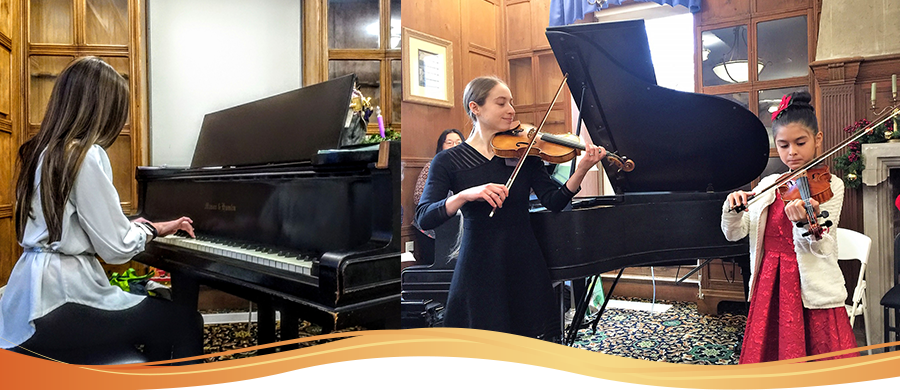
Online
Music for the Community
If you're interested in a particular category, you can sort performances by student age, instrument, singalong music, composer and so on - click on the orange tags under the text. We hope you and your family will enjoy watching our students share their music!
To have each week's videos and accompanying info sent to your inbox*, please subscribe via the orange button.
*Videos are delivered twice weekly; you can unsubscribe at any time, and we will never share or sell your info.
Subscribe to this Page
Displaying items by tag: Students age 12 to 14
Day 60 - Mozart Violin Concerto in D major
Violinist age 14 plays Mozart's Violin Concerto #4 in D, first movement
Wolfgang Amadeus Mozart (born 1756) wrote at least five violin concertos between 1773 and 1776, when he was not much older than this student. He probably wrote them for himself to play in his position as concertmaster (first chair) of the Archbishop of Salzburg’s orchestra.
This one was written in 1775, when he was 19. He did perform it at the time – but after he left the orchestra, he updated it and made it harder for the new concertmaster (Antonio Brunetti) who took over his job! It’s nicknamed the “Military” concerto, and if you listen to the violinist’s opening few measures you’ll hear why – they sound rather like a brass fanfare.
We love it when our older students play beautiful works like this with ease, inspiring beginner and intermediate students with a vision of what can happen if they keep on practicing. But as we make sure to point out to them: students like this were also once beginners learning to pluck open strings, just like the young man in yesterday’s video!
Day 56 - Handel Sarabande
Violinist age 14 plays "Sarabande" by Handel
It's probably no surprise that Georg Frederic Handel (1685-1759), an exact contemporary of Bach, also wrote many pieces featuring the dance forms that were popular among composers at the time. But it's hard to believe that the stately sarabande was originally thought to be a terrible influence - it was described in a "Treatise Against Public Amusements" in 1609 as "enough to excite bad emotions in even very decent people"!
The Sarabande probably had its origins in Central America, in particular Guatemala and Mexico, in the 16th century. It was actually banned in Spain by King Philip II in 1583, thanks to the sentiments above - but that didn't stop it being performed. It spread to Italy in the 17th century, and then - thanks to composers like Handel and Bach, who often used it in their suites of dances - to France, where it became a popular slow court dance.
Having started his career in his native Germany, in 1710 Handel became Kapellmeister (Music Director) at the court of Prince George of Hanover. But in 1714 Prince George became King George I of England, and Handel's success in England led him to settle there permanently. His famous "Water Music" suite was performed several times on barges on the River Thames for the King and his guests. In 1727 Handel was commissioned to write four anthems for the Coronation ceremony of the next king, George II, and one of these anthems, "Zadok the Priest", has been played at every British coronation ceremony since.
Day 55 - Bach Concerto for Two Violins
Violinists age 12 and 16 play Bach Concerto in D minor for Two Violins, second movement
The beloved "Bach Double", one of the composer's most famous works, is usually recognized by its fast first movement. Here, though, we're featuring the lyrical second movement with its expansive, lilting melody. The two violinists have equal parts that weave in and out of each other in a soulful musical conversation in the flowery Baroque style, taking turns with the melody and the accompaniment, finally coming to rest together.
Bach probably wrote this concerto when he was "Kapellmeister" - Director of Music - at the court Prince Leopold of Anhalt-Cothen between 1717 and 1723. This was a very happy employment situation for Bach - Prince Leopold, who was a musician himself, appreciated Bach's talents, paid him well, and gave him a lot of freedom to compose and perform whatever suited him. Much of the music of Bach that we've shown in this series comes from this time, including the orchestral suites and cello suites, as well as his music based on 18th century dances (here, here, and here).
Day 54 - Allegro by Fiocco
Violinist age 12 plays "Allegro" by Fiocco
Joseph-Hector Fiocco (1703 – 1741), born in Brussels, Belgium, was a composer and harpsichordist of the late Baroque period. His father, Italian composer Pietro Antonio Fiocco, and his older step-brother Jean-Joseph Fiocco gave him much of his musical education. He also learned Greek and Latin well enough to be able to become a schoolteacher in both those subjects.
He became music director at the cathedral in Antwerp, so much of the music he wrote was choral and religious in nature. He also wrote two suites of pieces for harpsichord - but ironically his best-known piece is this Allegro for violin, played by intermediate violinists the world over. "Allegro" literally means "happy", but in musical terms it means "fast and lively", and that's certainly the case with this piece!
Day 52 - Telemann Viola Concerto in G
Violist age 14 plays Telemann Concerto in G, first movement
Unlike many of the composers we've featured who were first taught music at home by their parents or other relatives, Georg Philipp Telemann (1681 - 1767) had an uphill battle to become a musician. He first had lessons from a local organist at age 10, and immediately became intensely interested in music - but his family was dead against the idea, and forbade him to take part in any musical activities at all. Nevertheless he carried on studying in secret - and managed to teach himself not only composing, but also the flute, oboe, violin, viola da gamba, recorder, double bass, and other instruments!
He went to university to study law, but music was clearly his destiny, and he very quickly became a professional musician. In fact, he became one of the most prolific major composers of all time: he composed more than 3,000 works, including 125 orchestral suites, 125 concertos, several dozen other orchestral pieces, many sonatas in five to seven parts, nearly 40 quartets, 130 trios, 87 solos, 80 pieces for small ensembles, and roughly 250 pieces for keyboard!
His Viola Concerto in G major is actually the first known concerto for viola, and was written some time between 1716 and 1721. This mellow "Largo" - a piece in a slow, broad tempo - is the first movement, giving the soloist the opportunity to show off the rich, deep tone of the viola. (See here for other viola performances.)
Day 50 - Czardas
Violinist age 12 plays "Czardas" by Monti
Day 49 - Bach Prelude from Suite in G
Violist age 14 and Cellist age 16 play Bach Prelude in G major
Because of their musical and technical difficulty, the Suites were not much performed until the great 20th century cellist Pablo Casals took them up, after discovering them in a thrift shop in Barcelona, Spain at the age of 13. His famous recordings of them were selected in 2019 for preservation in the Library of Congress.
Day 40: The Boy Paganini
Day 36: Mozart Minuet and Trio
Violist age 12 plays Minuet & Trio by Mozart
Day 12: Schindler's List
Violinist age 14 plays Theme from “Schindler’s List”
Steven Spielberg’s movie “Schindler’s List”, about the German manufacturer Oskar Schindler who saved more than 1000 Jews from the Holocaust by employing them in his factories, won 7 Oscars including Best Picture for Spielberg and Best Score (Music) for composer John Williams.
We feature its theme in homage to today’s observance of Holocaust Memorial Day, and in solidarity with victims of oppression everywhere.


